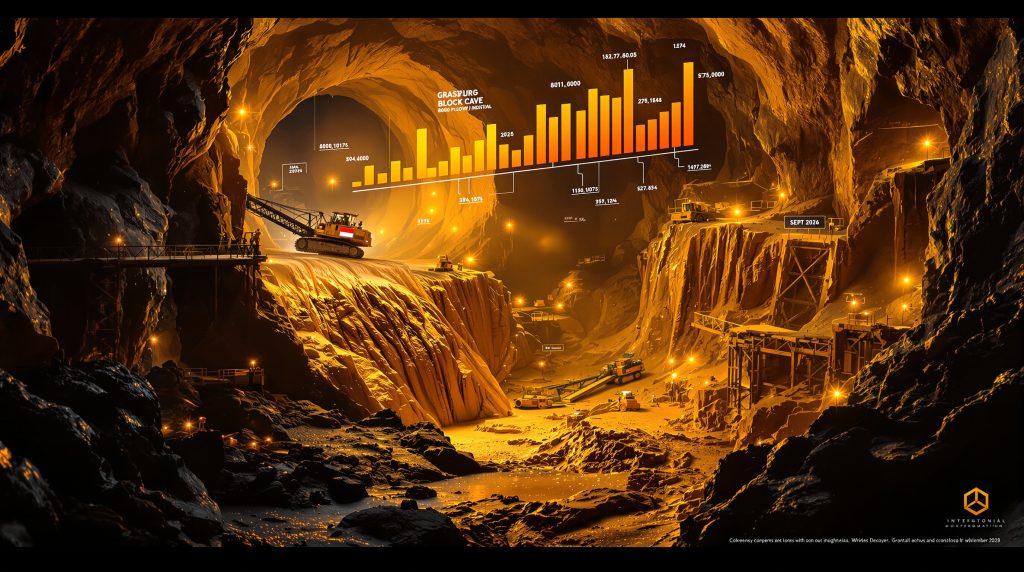Grasberg Mining Disaster Investigation: Complete Analysis of Indonesia's Worst Underground Flooding
The Indonesian mining industry faced one of its most devastating safety incidents in recent history when the Grasberg mining complex experienced a catastrophic underground flooding event on September 8, 2025. This disaster claimed seven lives and triggered an extensive investigation into Grasberg mud flow incident that has reshaped safety protocols for underground mining operations across Indonesia and beyond.
Located in Papua province, the Grasberg complex represents one of the world's largest copper and gold mining operations. The incident occurred during what officials described as regular mining operations, when approximately 800,000 metric tons of wet material from the former open-pit mining area suddenly breached into the underground Block Cave workings.
The scale and complexity of this disaster have provided critical insights into the unique challenges faced when transitioning mining operations from open-pit to underground methods. Furthermore, the investigation's findings carry implications far beyond Indonesia's borders, offering valuable lessons for mining operations worldwide that are undertaking similar operational transitions.
Timeline and Immediate Response to the September Incident
The catastrophic event unfolded rapidly on September 8, 2025, when massive volumes of wet material overwhelmed the underground infrastructure at the Grasberg Block Cave operation. The material originated from historical mining activities in the former open-pit area, creating an unprecedented challenge for emergency response teams.
Critical Timeline Elements:
- September 8, 2025: Initial material breach occurs during standard operational hours
- Immediate aftermath: Emergency response strategies activated across all mine levels
- First 48 hours: Initial search and rescue operations locate two workers
- Extended operation: Month-long search effort continues for remaining personnel
- October 2025: Five additional contractor workers recovered, confirming total fatality count
- November 7, 2025: Indonesian authorities officially conclude investigation
The flooding created what mining experts describe as a cascade failure, where the initial breach triggered progressive flooding through interconnected underground workings. This domino effect significantly complicated rescue operations and created dangerous conditions for emergency personnel attempting to reach trapped workers.
The wet material flow cut off primary evacuation routes, forcing rescue teams to establish alternative access points. The sheer volume of material involved represents one of the largest underground flooding events recorded in modern mining history, creating unprecedented technical challenges for both immediate response and long-term recovery operations.
Emergency response protocols proved inadequate for the scale of material movement experienced at Grasberg. Consequently, the incident highlighted critical gaps in existing safety systems designed to detect and respond to geological instability during mining transitions from surface to underground operations.
Scale of Material Movement and Geological Factors
The 800,000 metric tons of wet material that flooded the underground workings originated from accumulated water and loose material in the former Grasberg open pit. This volume represents approximately 533,000 cubic metres of material, assuming standard density calculations for wet mining debris.
Geological conditions at Grasberg present unique challenges due to the site's complex history of open-pit mining activities spanning several decades. The transition from surface mining to underground mining technology requires careful management of historical excavation areas, which can become sources of geological instability.
Material Composition Analysis:
The wet material likely consisted of a mixture of weathered rock, accumulated precipitation, and mining debris from decades of open-pit operations. Papua province experiences significant seasonal rainfall, which can accumulate in former pit areas and create unstable conditions when combined with loose geological material.
Underground block cave mining relies on controlled subsidence and material flow, but the uncontrolled introduction of external wet material from surface areas creates entirely different dynamics. However, the interaction between planned cave mining operations and unexpected material influx from historical mining areas represents a complex engineering challenge.
Investigation Methodology and Multi-Stakeholder Approach
The Indonesian Ministry of Energy and Mineral Resources, led by Deputy Mining Minister Yuliot Tanjung, conducted a comprehensive investigation involving multiple technical experts and international specialists. This multi-stakeholder approach ensured thorough examination of all potential contributing factors.
PT Freeport Indonesia collaborated with government authorities, international mining safety specialists, and independent technical consultants to determine both the immediate causes and systemic factors that contributed to the incident. The investigation into Grasberg mud flow incident lasted approximately two months, concluding on November 7, 2025.
Investigation Framework Components:
- Geological assessment: Detailed geological risk assessment of subsurface conditions and material stability
- Operational review: Examination of mining procedures and safety protocols in place
- Equipment evaluation: Assessment of monitoring systems and early warning capabilities
- Human factors analysis: Review of training programs, emergency procedures, and decision-making processes
- Regulatory compliance: Comparison against Indonesian mining safety standards and international best practices
- Root cause determination: Identification of primary and secondary factors contributing to the incident
The investigation methodology distinguished between immediate technical causes and broader systemic issues that may have contributed to the disaster. For instance, this approach ensured that both specific equipment failures and organisational factors received appropriate attention.
Deputy Minister Yuliot Tanjung confirmed that the evaluation process examined whether negligence or regulatory violations played a role in the disaster. This dual-track approach addressed both technical causation and potential legal accountability, ensuring comprehensive assessment of all contributing factors.
Government Oversight and Regulatory Framework
The Indonesian government's response demonstrated sophisticated understanding of the complexities involved in large-scale mining incidents. The Ministry of Energy and Mineral Resources implemented a phased evaluation process that recognised varying risk levels across different areas of the mining complex.
Areas directly affected by the mud flow required comprehensive safety validation before any consideration of operational restart. However, unaffected sections of the Grasberg complex could potentially resume operations more quickly, provided they met standard safety requirements.
This risk-differentiated approach reflects modern regulatory thinking that avoids blanket shutdowns when specific hazards can be isolated and managed. The ministry's evaluation criteria focused on determining actual safety risks rather than applying uniform restrictions across all operations.
Regulatory Decision-Making Process:
The government established clear conditional criteria for operational restart, with Deputy Minister Tanjung stating that activities would be permitted if deemed safe based on thorough evaluation. This performance-based regulatory approach prioritises actual safety outcomes over procedural compliance alone.
International mining safety experts have noted that Indonesia's response demonstrates sophisticated regulatory maturity, balancing worker safety concerns with economic considerations and avoiding unnecessary disruption to unaffected operations. Additionally, this approach has been praised by the Reuters commodities team for its measured response to the supply chain implications.
Comprehensive Safety Recommendations and Implementation Requirements
While specific details of the recommendations remain confidential, PT Freeport Indonesia confirmed receiving comprehensive improvement measures from the Ministry of Energy and Mineral Resources. Company spokesperson Katri Krisnati indicated that the organisation is actively implementing all recommended measures.
The recommendations likely address multiple layers of mining safety, from technical monitoring systems to organisational procedures and emergency response capabilities. Modern mining safety protocol best practices typically require integrated approaches that address equipment, procedures, training, and organisational culture simultaneously.
Anticipated Improvement Categories:
- Enhanced geological monitoring: Advanced systems for detecting material instability and water accumulation
- Early warning technologies: Real-time monitoring of conditions that could lead to similar incidents
- Emergency response optimisation: Improved evacuation procedures and alternative escape routes
- Worker safety training: Enhanced programmes addressing unique risks of transitional mining operations
- Modified operational procedures: Adjusted mining methodologies to reduce geological risks
- Regular safety verification: Increased frequency of independent safety audits and compliance checks
- Inter-departmental communication: Improved coordination between surface and underground operations
The confidential nature of specific recommendations reflects standard practice in mining safety investigations, where detailed technical requirements may contain proprietary information or security-sensitive details about mining operations.
Implementation Timeline and Compliance Framework
PT Freeport Indonesia has committed to full implementation of all recommendations before resuming operations in affected areas. This comprehensive approach demonstrates corporate commitment to addressing not just immediate technical issues but also broader systematic improvements.
The implementation process likely involves significant capital investment in new monitoring technologies, staff training programmes, and infrastructure modifications. Modern mining safety upgrades typically require 6-12 months for full implementation, depending on the scope and complexity of required changes.
Expected Implementation Phases:
- Immediate measures: Critical safety systems and emergency response improvements
- Short-term upgrades: Equipment installation and staff training programmes
- Long-term modifications: Infrastructure changes and operational procedure revisions
- Ongoing compliance: Regular monitoring and verification of implemented improvements
The success of these implementations will be measured not only through regulatory compliance but also through operational outcomes and continued safety performance over time.
Phased Operational Restart Strategy and Production Recovery
Freeport-McMoRan has developed a strategic restart plan that recognises varying impact levels across different areas of the Grasberg mining complex. This approach allows for efficient restoration of production capacity while maintaining rigorous safety standards.
The company's restart strategy prioritises areas that were unaffected by the September incident, including the Big Gossan mine and Deep Mill Level Zone. These operations could potentially resume during the fourth quarter of 2025, providing some production capacity while work continues on the main Block Cave operation.
Restart Timeline and Production Recovery:
- Q4 2025: Potential restart of Big Gossan mine and Deep Mill Level Zone
- Early 2026: Initial phases of Grasberg Block Cave restart
- Mid-2026: Gradual production ramp-up to pre-incident levels
- Late 2026: Full operational capacity restoration, pending safety compliance
The Grasberg Block Cave represents approximately 70% of PT Freeport Indonesia's projected copper and gold output through 2029, making the timeline for its restart critical for both company performance and global commodity markets.
Economic Impact and Supply Chain Implications
The extended shutdown of Grasberg Block Cave operations has significant implications for global copper supply chains. As one of the world's largest copper and gold producers, any disruption at Grasberg affects international commodity prices and supply availability.
The 70% production dependency on the Block Cave operation means that even with Big Gossan and Deep Mill Level Zone operational, PT Freeport Indonesia's total output remains substantially constrained until the main operation resumes full capacity.
Market Impact Considerations:
- Short-term supply constraints: Immediate reduction in available copper and gold from Indonesian production
- Price volatility: Global commodity markets monitoring restart progress closely
- Customer relationships: Long-term supply agreements requiring adjustment and accommodation
- Competitive positioning: Market share implications during extended shutdown period
The company's phased restart approach aims to minimise long-term market disruption while ensuring that safety improvements are fully implemented and verified before resuming full operations. Furthermore, industry analysts at Mining Weekly have noted the positive market response to the completion of the investigation phase.
Industry-Wide Safety Implications and Technology Innovation
The Grasberg incident has prompted significant discussion within the global mining industry about safety protocols for operations transitioning from open-pit to underground mining methods. The complexity of managing historical mining areas while developing new underground workings presents unique challenges that require innovative solutions.
Mining companies worldwide are reviewing their own transitional operations to identify potential vulnerabilities similar to those experienced at Grasberg. This incident serves as a case study for the industry, highlighting the importance of comprehensive risk assessment when dealing with complex geological transitions.
Industry Learning Opportunities:
- Advanced monitoring technologies: Development of sophisticated systems for detecting geological instability
- Predictive analytics: Use of data analysis to anticipate potential hazardous conditions
- Emergency response optimisation: Improved procedures for large-scale underground emergencies
- International safety standards: Development of specific protocols for transitional mining operations
- Technology integration: Better coordination between surface and underground monitoring systems
- Training programme enhancement: Specialised education for workers in transitional mining environments
The incident is likely to accelerate adoption of advanced technologies in underground mining operations, including automated monitoring systems, real-time geological assessment tools, and enhanced communication systems for emergency response.
Global Regulatory Response and Standards Development
Mining regulatory authorities in multiple countries are examining the Grasberg incident to determine whether similar vulnerabilities exist in their jurisdictions. This examination may lead to enhanced safety requirements for transitional mining operations globally.
International mining safety organisations are likely to incorporate lessons learned from Grasberg into updated best practice guidelines and safety standards. The incident provides valuable data for improving safety protocols in similar geological and operational conditions worldwide.
Expected Regulatory Developments:
- Enhanced inspection requirements: More frequent and detailed safety assessments for transitional operations
- Technology mandates: Required implementation of advanced monitoring systems
- Training standards: Improved requirements for worker education and emergency response preparation
- International coordination: Greater sharing of safety information between mining jurisdictions
- Research initiatives: Increased funding for mining safety research and technology development
The global nature of the mining industry ensures that safety improvements developed in response to the investigation into Grasberg mud flow incident will benefit mining operations worldwide. Consequently, regulatory reforms updates are expected across multiple jurisdictions.
Technical Analysis of Block Cave Mining Challenges
Block cave mining represents one of the most complex underground mining methods, relying on controlled subsidence and gravity flow of materials. The technique involves creating large underground cavities that allow ore to be extracted through carefully planned collapse sequences.
The interaction between planned cave mining operations and unexpected material influx from surface sources creates technical challenges not typically encountered in conventional underground mining. The Grasberg incident demonstrates how external factors can overwhelm engineered systems designed for controlled material flow.
Block Cave Technical Considerations:
- Controlled subsidence: Careful management of underground cavity development
- Material flow dynamics: Understanding of how different materials behave under gravity flow conditions
- Structural integrity: Maintaining stable access routes and evacuation systems
- Water management: Controlling groundwater and surface water infiltration
- Monitoring requirements: Comprehensive systems for detecting changes in geological conditions
- Emergency planning: Specialised procedures for large-volume material flow incidents
The wet material that flooded Grasberg's underground workings likely behaved differently from the dry, fragmented ore typically managed in block cave operations. Understanding these behavioural differences is crucial for preventing similar incidents in the future.
Geological Risk Assessment in Transitional Mining
The transition from open-pit to underground mining requires comprehensive assessment of geological conditions that may have changed during decades of surface extraction. Historical mining activities can create unstable conditions that persist long after surface operations conclude.
Accumulated water in former pit areas represents a particular hazard, as seasonal rainfall and groundwater infiltration can create substantial volumes of material with unpredictable flow characteristics. The interaction between water-saturated materials and underground mining infrastructure requires specialised engineering analysis.
Risk Assessment Components:
- Historical excavation mapping: Detailed documentation of all previous mining activities
- Hydrological analysis: Understanding of water accumulation patterns and drainage systems
- Geological stability assessment: Evaluation of rock mass conditions and potential failure modes
- Material characterisation: Analysis of accumulated debris and its flow properties
- Structural analysis: Assessment of interactions between surface and underground workings
- Monitoring system design: Development of early warning systems for material movement
The complexity of these assessments requires interdisciplinary expertise combining geology, hydrology, structural engineering, and mining engineering knowledge.
Long-Term Safety Management and Continuous Improvement
The Grasberg incident emphasises the importance of continuous safety improvement rather than static compliance with minimum standards. Modern mining operations require adaptive management systems that can respond to changing geological conditions and operational requirements.
Effective safety management in complex mining environments requires integration of multiple information sources, including geological monitoring, operational data, weather conditions, and worker observations. The ability to synthesise this information and make informed decisions is critical for preventing similar incidents.
Continuous Improvement Framework:
- Real-time monitoring: Ongoing assessment of geological and operational conditions
- Data integration: Combining information from multiple sources for comprehensive risk assessment
- Adaptive procedures: Flexible operational protocols that can respond to changing conditions
- Regular review: Periodic evaluation of safety systems and their effectiveness
- Technology updates: Ongoing adoption of improved monitoring and control technologies
- Knowledge sharing: Communication of lessons learned within the industry
The implementation of comprehensive safety improvements at Grasberg will provide valuable data on the effectiveness of various technologies and procedures, contributing to industry-wide safety enhancement.
Future Outlook for Grasberg Operations and Global Mining Safety
The successful resolution of safety issues at Grasberg will serve as a model for managing complex geological challenges in transitional mining operations. The comprehensive investigation into Grasberg mud flow incident and improvement process demonstrates the importance of thorough technical analysis and systematic implementation of safety measures.
The incident's impact on global copper markets highlights the critical importance of maintaining operational safety in major mining operations. Supply chain disruptions from safety incidents can have far-reaching economic consequences beyond the immediate operational impacts.
Key Success Factors for Recovery:
- Comprehensive implementation: Full adoption of all recommended safety improvements
- Ongoing monitoring: Continuous assessment of safety system effectiveness
- Industry collaboration: Sharing of lessons learned with other mining operations
- Regulatory compliance: Maintaining adherence to enhanced safety requirements
- Technology advancement: Continued adoption of improved safety technologies
- Workforce development: Enhanced training and safety awareness programmes
The lessons learned from the Grasberg investigation will contribute to improved safety standards and practices throughout the global mining industry, potentially preventing similar incidents at other operations worldwide.
Disclaimer: This analysis is based on publicly available information as of November 2025. Mining operations involve inherent risks, and safety conditions can change rapidly based on geological, operational, and environmental factors. Investment decisions should not be based solely on operational safety considerations, and readers should consult with qualified professionals before making any financial commitments related to mining investments.
Ready to Identify the Next Major Mining Discovery Before the Market Reacts?
Discovery Alert's proprietary Discovery IQ model delivers real-time alerts on significant ASX mineral discoveries, instantly empowering subscribers to identify actionable opportunities ahead of the broader market. Understand why historic discoveries can generate substantial returns by exploring major breakthrough announcements that have delivered exceptional investor outcomes.




